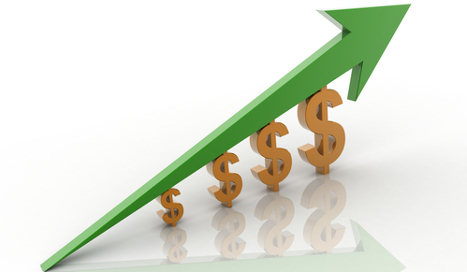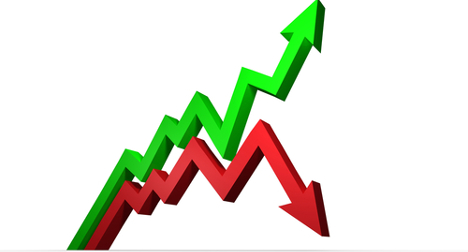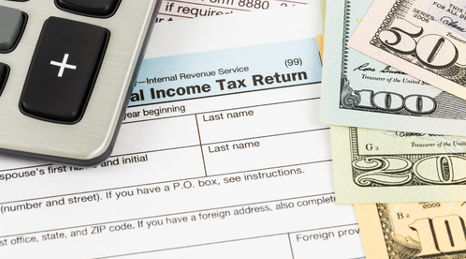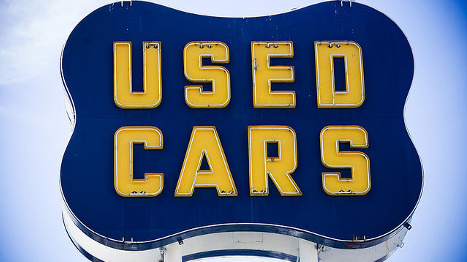The fact that the date of his upcoming retirement, April 1, coincides with the prank-happy holiday is purely a coincidence.
“To start with, that’s not an April’s Fool’s joke,” Ricky Beggs told Auto Remarketing by phone on Tuesday afternoon in his first interview since his retirement was announced.
Yes, the senior vice president and editorial director at Black Book is retiring after 34 years with the company. He and his wife, Vicki, plan to “catch our breath and enjoy it.”
Certainly well-deserved for someone who’s been one of the most recognizable and respected voices of an industry. And it’s a two-way street — the respect garnered by Beggs among his remarketing peers is mutual.
Calling the remarketing business the best part of the auto industry, Beggs said that “it’s new and fresh every day; it’s always changing.”
His favorite part of the business? “The excitement of the industry and the people that are in it,” he said.
Beggs said the decision to retire was tough. He began thinking about it three years ago and ultimately decided last year.
“This has been my life. To step away from that was a challenge,” he said. “It was hard.”
In his three-plus decades in remarketing business, there have been some big changes overall, including the amount of information that’s out there, where that info comes from and how it is delivered, he said.
One thing that won’t change, Beggs said, is the level of service his company provides, with Anil Goyal heading up editorial and analytic operations and Kevin Giddens set to lead the day-to-day editorial operations.
“They won’t skip a beat with the knowledge and insight we have here,” he said.
Black Book announced Tuesday that senior vice president and editorial director Ricky Beggs will retire on April 1 after a 34-year career.
“It has been an honor to work alongside Ricky who truly has become an industry legend,” said Black Book president Tom Cross. “His legacy of leadership and his dedication to excellence have left an enduring mark on our company, ensuring our position as the industry’s most reliable and accurate source of vehicle valuation and insight.”
Beggs started with Black Book in 1981, joining the company as used-car editor before being named managing editor in 1990.
“I will be forever grateful to Black Book for giving me the opportunity to be a part of a team that has represented the interests of the automotive community with respect and integrity all these years,” Beggs said. “I’m certainly proud of our accomplishments, and I leave knowing Black Book is well positioned for its next phase of growth and development.”
Heading up editorial and analytic operations for Black Book will be Anil Goyal, vice president of automotive valuation and analytics.
“We’re delighted to have Anil take over responsibility for both our editorial and analytic operations,” said Cross. “Anil brings a completely new set of skills to Black Book and deep background in strategy and analytics having held a number of senior positions in the banking industry in risk management, marketing, and operations.”
Named managing editor and reporting to Goyal will be Kevin Giddens, who will lead the day-to-day editorial operations.
“Black Book has a great foundation in our people, data and technology. I am excited about combining advanced analytics with our editorial team’s deep automotive knowledge to provide enhanced insights to our customers,” said Goyal.
More: Beggs talks to Auto Remarketing in his first interview following Tuesday's announcement.
Tax season is continuing to drive price retention in the lanes as refunds start streaming in.
According to Black Book editorial director Ricky Beggs, the season “continues to bring positive numbers and helped drive the largest number of necessary (price) adjustments in a weekly period in over a year.”
During the latest “Beggs on the Used Car Market” video report, the Black Book executive reported an average of 2,503 price adjustments per day in the lanes last week.
And overall, price movement brought stronger price retention to both the car and truck segments.
The cars saw an average decline of $32 last week after dropping by $49 the week prior. Trucks followed a similar trend, seeing a $25 drop after prices fell by $37 two weeks ago.
The most stable car segments, according to Beggs, were the entry sport cars with a $18 drop; the upper mid-size cars, which saw prices fall by $19; and the full-size cars, with a drop of $20.
“These three segments are also the most stable in change within the cars for the past three weeks, with an average change of -$26, -$15 and -$22 respectively,” Beggs reported.
Switching over to cover the truck market, Beggs said these vehicles “continue to get plenty of attention in the lanes.”
Interestingly, 44 percent of the price adjustments for trucks involved positive movement, while only 26 percent of cars saw prices move up. This movement is perhaps not surprising as gas prices remain low, providing an optimum market for larger units.
And truck market strength isn’t confined to the auction lanes.
“Not only are these trucks moving better within the wholesale channels, that’s the case within the retail market as well,” Beggs said.
In the lanes, the compact SUVs, which saw a price increase of $52 last week, have seen positive changes for seven weeks in a row.
Cargo minivans are also proving strong in the lanes, with a price increase of $55 last week.
Lastly, Beggs pointed out the midsize pickup segment is also “getting a lot of attention in both the new and used markets right now.”
This segment finished last week off with an average decline of $2, after dropping by $7 the week before.
The complete video recap can be viewed above.
Used-price drops slowed as last year closed out, and February is off to a mild start when it comes to depreciation.
Signs of tax season are also starting to rear their head. According to the latest Guidelines report from NADA Used Car Guide, used-vehicle prices are expected to rise by 1 percent to 1.5 percent this month.
This movement comes after NADA UCG reported a 0.5-percent price increase from December rates during the first month of 2015.
“A growing wave of consumers receiving tax refunds has traditionally sparked demand for used vehicles over the first quarter of the year,” Jonathan Banks, executive automotive analyst at NADA Used Car Guide, said in the report.
March is expected to continue the trend with predicted price spikes of 0.5 percent to 1 percent.
But after the tax season surge, used prices are expected to fall at a rapid rate, due in part to the expected influx of off-lease vehicle supply flooding the market.
“If movement plays out as we expect, prices would finish the quarter on par with last year’s Q1 level,” Banks said.
Gas prices, which remain at record low rates, are expected to play a part in ramping up truck prices during February and March. And consequently, the industry can expect to see more “muted” car-price growth over the period.
According to the report, luxury vehicle prices are expected to continue to slide during the remainder of February and into March.
Trends expected for this month and beyond echo similar movement in January.
With gas prices dropping, large pickup prices were 7.9 percent high this past January than during the same period of 2014.
The midsize utility and midsize van prices also saw strong price retention, with prices rising by 4.4 percent and 3 percent year-over-year, respectively.
Luxury large car, luxury midsize car and subcompact car prices were on average 2.5 percent lower relative to last year, NADA UCG reported.
The first week of February continued what analysts are calling “mild” depreciation to start off the new year.
In January, depreciation rates were mellow, as dealers readied for the tax season.
That’s according to Black Book’s latest depreciation report, which shows the average price for a used vehicle for model years 2009-2012 saw prices drop by 1.2 percent during January.
This reading represented little change from the 1-percent decline for December.
Domestic cars performed the best this past month, with prices only dropping by 0.6 percent, while domestic trucks saw a 1.6-percent drop in price.
Import cars fell by 1.2 percent, while import trucks saw prices drop by 1 percent.
Three car segments — full-size cars, entry-level cars and compact cars — represented the best-performing segments in January, showing signs of tax-season trends.
“With the tax season right around the corner, it’s very telling that the top three vehicle segments were represented by cars often in the crosshairs of the tax rebate buyer,” said Ricky Beggs, editorial director at Black Book. “With the economy continuing to improve, it will be interesting to see if other segments at a slightly higher price point become as popular this year with the average tax buyer.”
Full-size cars were out in front with the strongest price retention, with wholesale prices increasing by 0.1 percent in January. This segment finished the month off with an average price of $11,659, a 12.4 percent year-over-year decline.
Next up were the entry-level cars and compact cars, both with drops of 0.5 percent.
Price retention wasn’t quite as strong for some of the larger units in January, even as gas prices remain low.
Passenger minivans, for example, saw prices drop the most out of any segment with a drop of 2.2 percent in January. The average price for a passenger minivan at the end of January was $14,639, a 11.6 percent year-over-year decline.
Full-size SUVs experienced the second largest rate of depreciation, with prices falling by 2 percent last month, ending January with an average price of $22,255. This represents a 9.6 percent year-over-year drop.
But not all truck segments saw larger-than-average depreciation rates.
The full-size cargo vans continued to perform well with the lowest depreciation rate for trucks in January of 0.5 percent.
Looking ahead to the full year, Black Book expect 2015 depreciation to come in at 14.5 percent, relatively mild when looking at the average pre-recession annual deprecation of 15 to 18 percent.
The first week of February came with more positive price adjustments at auction after prices fell a bit more than usual during the last week of January.
Overall, car prices at auction dropped a mere $32 (or .22 percent) this past week, which represents the strongest price retention seen in over a month.
That’s according to the latest “Beggs on the Used Car Market” video report, which this week featured Tim West, vice president and North American auction director at Black Book, filling in for editorial director Ricky Beggs.
The largest decline seen among car segments was in the premium sporty cars and luxury level cars, which both saw a drop of $73.
On the other hand, the entry levels cars saw the smallest level of change declining by only .01 percent.
Analyzing this past week’s price movement, West said, “This minor level of change appears to be reflecting the stabilization in fuel prices with gasoline prices rising 2 cents to an average price of $2.07 per gallon. However, diesel is still falling with a 3-cent decrease to $2.83.”
Perhaps falling diesel prices are turning consumers back to the truck market, as prices for these segments continue to be stronger than their smaller counterparts.
This week, truck values fell by a mere $25 (or .18 percent), which was the lowest drop seen over the past eight weeks.
The full-size pickups saw the strongest price retention last week, with rates rising by an average of $14.
West explained this segment, as well as the compact pickups and SUVs have been leading the market in terms of residuals.
“Looking closer into the truck segments, compact and full-sized pickups along with compact SUVs have held their values better than the other truck segments for five consecutive weeks,” West said. “This trend has continued into February; the compact SUV segment increased another $9, or .06 percent. Some of the strength and improvements in the wholesale market can be attributed to the continuation of low supply, increased demand and low fuel prices.”
On the other side of the spectrum, the largest drop in price among trucks last week was seen in the luxury SUV segment with a drop of $124.
“Overall we see the market movement for the first week of February returning to a more positive position unlike the ‘last week of the month’ market we discussed last week,” West concluded.
To view the full report, see the video above.
The top executive at Group 1 Automotive doesn’t foresee a “dramatic” fall-off in used-car prices, and while there are certainly downward pressures on values, Earl Hesterberg pointed out a few mitigating factors at play when he addressed questions during the company’s quarterly conference call.
In the Q&A portion of Thursday’s call, an analyst brought up the widespread concerns about a potential drop in used-car prices that seem to be at odds with the transaction price strength that Group 1 and its peers have enjoyed.
In addressing the analyst’s question, Hesterberg — Group 1’s president and chief executive officer — acknowledged pressures that are negatively impacting used values, but also explained other dynamics at work.
“I think the relative price level probably will continue to be under a little bit of pressure, but as you may have noticed, our CPO business grew a lot,” Hesterberg said.
“And I think because there’s an increasing supply of off-lease vehicles, particularly for the luxury brands, that’s driving up some of the average transaction prices and that will probably continue,” he continued. “But there will also continue to be increasing off-lease supply, which may put a little negative pressure.
“So, maybe the mix is richening up a bit, but I think the supply and the aggressive marketing of new vehicles is going to continue to put a little downward pricing pressure on used-vehicle prices overall,” Hesterberg said.
The analyst then followed up with a question to gauge how problematic this trend may be when it comes to trade-in values and consumers not having as much value in their cars. Again, Hesterberg does not see this being a huge problem, at least in the short term.
“I don’t think it’s going to be a big deal in the near term. I think that only becomes a big deal if it’s something dramatic,” he noted. “And I don’t see anything dramatic happening.”
NADA Used Car Guide addressed some of these very concerns in its latest Perspective report.
While listing several factors likely to drive strength in used prices — including economic gains, declining unemployment, gains in home prices and significantly lower fuel costs — NADA said it believes these positive impacts won’t be able to match the downward pressures. Credit conditions won’t be quite as rosy, and the impact of that plus new-market pricing pressures and what NADA called the most important factor (increased used supply) will dampen used prices.
How much? NADA pinpoints the year-over-year decrease for vehicles up to 8 years old somewhere between 2 percent and 2.5 percent this year.
“Looking further ahead, used price movement will be determined by a variety of factors, some of which will be harder to predict than others. Automaker production and incentive actions are just two factoring examples,” NADA’s report explains.
“However, we can pinpoint used supply growth with far greater accuracy and can state with confidence that the additional volume will pressure down prices even more in the coming years,” it adds. “Recognizing this, lenders, automakers and others with longer-term investments in used vehicles can better prepare for the challenges that lie ahead.”
Offering a different take, Jeffrey Brown, the new CEO of Ally Financial, also addressed used-car prices during his company’s most recent quarterly call.
“Used-car prices have continued to soften. I think that is more a supply dynamic than anything else. Again that’s created some volatility in some of our margin line items where lease gains run through,” he said. “We would expect used-car prices to keep coming down in the neighborhood of about another 5 percent this year.”
Editor's Note: Staff Writer Nick Zulovich contributed to this report.
Kentucky’s men’s basketball team just won the most recent of its eight NCAA national championships the last time used-vehicle values rose to the level Manheim determined as the January reading.
Manheim reported that wholesale used-vehicle prices (on a mix-, mileage-, and seasonally adjusted basis) increased in January for the fourth consecutive month. This movement pushed the January Manheim Used Vehicle Value Index to a reading of 125.3, which represented an increase of 2.5 percent from a year ago.
Chief economist Tom Webb indicated January’s price rise pushed used-vehicle values to their highest level since April 2012. (And for reference for the wholesale observers who follow college basketball, Kentucky defeated Kansas at the start of that month for the national title.)
“The fact that wholesale prices are now back to a level last seen when off-lease volumes were at their trough is contrary to expectations of most analysts,” Webb said. “Wholesale prices are not, however, in conflict with the continued rise in new-vehicle transaction prices (net of incentives) or the strong retail used-vehicle results being reported by most dealers.”
Looking at the six vehicle categories Manheim tracks monthly for this report, only one registered a price decline. And it was just a 0.5-percent softening for compact cars, but the small movement still drew a reaction from Webb.
“Wholesale pricing for compact cars was weak in January. That has been the trend for more than a year as a result of competitive pricing on the new vehicle side and abundant offerings in the wholesale market,” he said. “The pricing pressure in this segment has only been intensified by the plunge in gas prices.”
Prices for the remaining five segments all moved higher, including:
— Midsize cars: up 1.4 percent
— Luxury cars: up 1.6 percent
— Pickups: up 8.2 percent
— SUV/CUV: up 2.9 percent
— Vans: up 3.0 percent
“In January, relative pricing strength across price tiers was extremely consistent and seemingly uninfluenced by shifting volumes for the various price points,” Webb said. “This suggests an efficient market that has erased earlier price anomalies through the competitive bid process.”
Elsewhere within the wholesale landscape, Manheim noticed auction prices for dealer-consigned units sold in January were “noticeably higher” than a year ago.
Webb attributed the trend to growing volumes and slightly rising mileage.
Manheim also mentioned pricing for rental risk units held steady last month.
“Auction prices for rental risk units sold in January rose relative to December after adjusting for mix and mileage, but were down absent the adjustment,” Webb said.
“Adjusted prices were basically level with a year ago. Average mileage on units sold in January remained at the record high level posted in December,” he went on to say.
New- and Used-Vehicle Sales Commentary
Beginning with a look at turning new metal, Webb described new-vehicle sales and pricing being “on track” to start 2015.
Manheim reported new cars and light-duty trucks sold at a seasonally adjusted annual rate of 16.7 million in January.
“More than a handful of makes had their best January ever,” Webb said.
Webb referenced a Kelley Blue Book report that stated average transaction prices in January climbed 5 percent from a year ago, driven in part by mix shifts.
“Even the government’s new vehicle component of the Consumer Price Index, which is mix- and quality-adjusted, remains up year over year,” Webb said. “As a result, although wholesale values relative to the New Vehicle CPI are elevated (on both a lagged and current basis), they are not outside of historic norms.”
Turning back to the used market, Webb pointed out that used-vehicle sales and profits remain strong.
In January, dealer sales of used vehicles rose 1.4 percent, according to CNW Research, while Autodata Corp. highlighted that certified pre-owned sales jumped 17 percent to begin the year.
“That was after both publicly traded and private dealer groups indicated strong used vehicle operations in the fourth quarter. Volumes were up with no sacrifice to gross or turn rates,” Webb said.
The Manheim economist then elaborated about what the result might be when final numbers for the seven publicly traded dealerships are reported later this month.
“It is almost inevitable that fourth-quarter same-store used unit retail volumes will show a rise for the 22nd consecutive quarter,” Webb said. “And it is possible that gross margins held steady after several years of decline.
“We expect that labor market and credit conditions will continue to be favorable for used unit sales for the remainder of 2015,” he continued. “Maintaining margin, however, will require superior inventory management in the face of what may be volatile industry conditions and easing wholesale values.”
Along with explanations for why lease residuals will be under pressure and late-model depreciation will be considered as “volatile,” the latest joint vehicle depreciation report from Black Book and Fitch Ratings indicated vehicle depreciation is expected to accelerate in 2015.
Analysts came to that forecast based on increased used-vehicle supply and larger off-lease volumes placing pressure on retention rates
According to the report, 2014 new-vehicle sales finished the year at 16.5 million units, and Black Book is forecasting new-vehicle sales to finish north of 16.7 million units this year. Analysts pegged the annual depreciation rate on used vehicles in 2014 at 12.1 percent, slightly lower than their initial forecast.
Black Book believes annual depreciation levels on used vehicles will continue to trend toward pre-recession historical rates and climb to 14.5 percent in 2015.
“2014 depreciation was defined by pockets of volatility due to seasonality, harsh weather patterns and falling fuel prices impacting smaller cars and trucks of all sizes,” said Anil Goyal, vice president of analytics and strategic partnerships for Black Book.
Looking ahead, lower consumer demand and CAFE-driven model competition will place higher depreciation pressure on smaller car segments particularly, but trucks should have stable retention in 2015 due to balanced production levels and strong housing and service economies,” Goyal continued.
The Black Book-Fitch vehicle depreciation report is a joint venture by the two companies utilizing Black Book’s used vehicle depreciation data, and Fitch’s U.S. auto ABS indices data.
Black Book tracks used vehicle market depreciation rates providing an understanding of how vehicle prices impact automobile lenders and lessors, auto ABS transactions, consumers and other auto market constituents.
“Leveraging accurate and timely collateral data trends from Black Book are critical to auto lenders especially given the changing landscape for risk potential in 2015,” said Hylton Heard, who is senior director of Fitch Ratings.
Lease Residual Value Commentary
Fitch projected that residual value losses should increase in vehicle lease transactions this year since depreciation is expected to move close to 15 percent.
Fitch’s RV Index declined throughout most of last year as used-vehicle values softened and depreciations inched higher. The firm acknowledged its index level started 2014 at elevated levels, ranging from 6.05 percent to 10.08 percent through the first half of the year before settling at 3.87 percent by December.
“Clearly, softer wholesale values from elevated off-lease volumes and vehicle trade-ins slowed RV performance in the latter half of 2014,” Fitch analysts said in the report.
Fitch pointed out that it rates approximately $25 billion of auto lease ABS outstanding that’s been issued from 10 U.S. platforms. The firm is anticipating that vehicle returns will increase this year, pushing off-lease volume higher by more than 10 percent as compared to 2014.
“Even with this trend, Fitch expects minimal impact on ratings performance in 2015, and the outlook for asset and ratings performance is stable,” the report said.
“Transactions are well enhanced to withstand lower RV in 2015, particularly giving current enhancement levels with RV loss proxies derived utilizing the very weak late 2008-early 2009 period asset performance,” analysts continued.
Late-Model Depreciation Analysis
Report orchestrators explained annual depreciation of late-model vehicles exhibits significantly larger levels of depreciation. They noted this trends happens because of a greater push for differences in new-to-used vehicle prices as new-model sales continue to increase along with increasing actual transaction prices.
“Certain manufacturers are even using higher incentives for particular models with elevated inventory levels to increase sales and reduce stock,” analysts said in the Black Book and Fitch report.
The report continued by mentioning what the firms considered to be “amazing” depreciation patterns exhibited in the compact SUV segment. Analysts said these patterns develop because there is a “limited number of players” in the segment, led by the “almost iconic Jeep Wrangler and the especially popular four-door variants.”
Editor's Note: The entire vehicle depreciation report produced by Black Book and Fitch can be downloaded here.
The first month of 2015 is in the books, and Black Book editorial director Ricky Beggs shared his reactions to last week’s vehicle price movements in the latest “Beggs on the Used Car Market” video report.
Though pointing out that fuel prices continued to fall — by 2 cents and 7 cents for gas and diesel, respectively — Beggs said the most eyebrow-raising statistic in his weekly segment report, which reflected similar depreciation levels to last year, was this:
“If there was one thing that caught my attention from the weekly segment report, it was that the overall average segment change was the greatest amount for the cars and trucks over the past three months,” Beggs said. “And in the trucks, today’s market at -$47 was very similar to the one year ago change of -$45. The cars at -$74 this past week is just under the -$86 change level of one year ago."
The decline does not end there: according to Beggs, eight out of the 10 car segments tracked show larger levels of decline than the week before. The only two segments that had any sort of gain — entry-level cars and upper midsize cars — gained only slightly, increasing by $1 each, on average.
Beggs was not sure if the changes in prices were driven by gas prices or “end-of-the-month” market action.
“Following the ‘end-of-the-month’ market thought, the trucks had 13 of the 14 reporting segments with the same or greater declining levels as compared to two weeks ago,” Beggs said. “The remaining segment, the full-size pickups, at only -$5, are the second best level of retention over the past few weeks, only behind the amazingly strong compact SUVs, which have had positive changes week over week for the past five weeks.”
The complete report can be viewed above.












